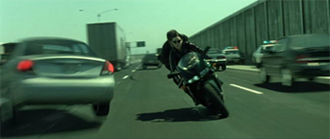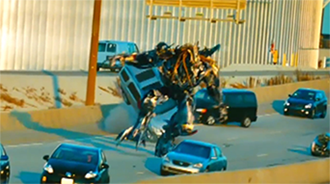InTrans / Aug 13, 2015
Movies in motion: Transportation in The Matrix and Transformers
Go! Magazine
 posted on August 13, 2015
posted on August 13, 2015
You know that movie? You know, the one with the crazy car chase? Or really, any movie directed by Michael Bay? Intensity. Fast vehicles. Explosions. Those kinds of movies have me absolutely glued to the screen. But then, as the credits roll, I start thinking to myself, “What just happened?” I start to question everything. “How much money did they spend just on that scene?” “Was that crash even real?”
Let’s take a look at a few of these film offenders.
First, let’s consider the 2003 film, The Matrix Reloaded. This first sequel to the iconic blockbuster The Matrix follows characters Neo and Trinity in Zion. Did you know that throughout the entire filming process, 94 stunt doubles were hired as stunt drivers and martial artists? And you can’t forget that infamous highway car chase. Why was this chase so impressive? Well, the directors of the Matrix series, The Wachowski Brothers, put up $1.5 million to build a temporary highway on an old naval base in California. Once they finished shooting the highway scene, which took about three months, the highway was deconstructed and 90 percent of the building materials (about 27 million pounds worth) was donated to create housing and insulation in Mexico.

Ever wonder where all the cars (aka destroyed, demolished, ruined cars) came from? General Motors donated an impressive 300 cars to create one of the most intense car chase scenes in cinematic history! And with a budget of $150 million, The Matrix Reloaded banked a return of more than $742 million. The main actor who played Neo, Keanu Reeves, is said to have made $126 million from this movie. However, Reeves is said to have donated a lot of his money back to the special-effects technicians and costume designers who put in countless hours making The Matrix Reloaded.
Not impressed yet? Let’s look at the third (originally final) installment of the live-action Transformers film series: Transformers: Dark of the Moon. This 2011 film, directed by Michael Bay, included a robot chase scene that destroyed 532 cars.Reduce. Reuse. Recycle. Did you know that because many of the donated vehicles had flood damage, they were originally headed to the scrap yard?

While Transformers: Dark of the Moon spent more than $195 million during the making of the film, they were able to get a huge return at the box office of more than $1.1 billion, ranking in the top ten highest grossing movies of 2011.
Now it’s time to break the third wall in order to answer my other question: “Are the intense car chases real?” Obviously, the robots crashing onto the highway in Transformers isn’t real, but what about The Matrix Reloaded? Sorry to say, but barely anything is real anymore when there is a technique called “computer-generated imagery”? (CGI), which make the stories come to life. Oh yeah, and, don’t forget, move!
What is CGI?
A CGI animator is an artist, web designer, and, in the case of transportation (aka car chases), an engineer. Anyone trained to do CGI animation usually starts out doing freelance work, but can work their way up to becoming part of a special effects team for a film. When working on a team, they create dynamic CGI rendered as a movie by animating a still object into a moving object. That’s right! This technology has allowed movies to make “impossible” things like flying or dodging a bullet (like in The Matrix series) and making robots come to life (like in Transformers) a reality It starts with a sketch of a figure. This sketch is then scanned and put into the computer and made 3D by sculpting it in a program. The sculpting stage requires a lot of research to make the figure realistic in terms of its features. From there, the figure is staged in different successive positions (imagine a flipbook) through a process called “animation.” The final stage involves altering the color, texture, and movements of the figure to make it more realistic.
The process of CGI can be quite time consuming. For instance, each of the 16 “autobots” in Transformers took about 30 weeks to visually build. And since the Transformers film was planned to be viewed in 3D, the special effects crew had to make sure the design of the autobots were visually appealing and detailed enough to be seen up close. In order to make all of these special effects happen, the special effects team had what’s called a “render farm,” which is a fancy term for a network of high performance computers to help speed up the CGI process. This render farm has the ability to do more than 200,000 hours of rendering in 24 hours, equivalent to almost 23 years in one day!
How does this effect the movie industry?
Remember the goal: Making the impossible, possible. Though CGI started way back in the 1960s with the creation of computers, it really only gained traction in the 1970s with the original Star Wars movie. In Star Wars, CGI was used by animating handmade miniatures built from scratch to add realism to the film. From the first films to today’s big box office hits like Avatar, The Hobbit, and Jurassic World, CGI has fostered creativity in new ways never thought possible in filmmaking.
Related links
https://en.wikipedia.org/wiki/The_Matrix_Reloaded
http://www.imdb.com/title/tt0234215/trivia
https://en.wikipedia.org/wiki/Naval_Air_Station_Alameda
https://en.wikipedia.org/wiki/Car_chase
http://www.quora.com/What-is-the-process-involved-in-filming-at-a-public-area
http://www.shortlist.com/entertainment/films/20-ultimate-car-chases
By Jackie Nester, Go! Staff Writer